#malted grain flour
Text
Easy Slow Cooker Sourdough Sandwich Bread
World's 1st Easy Slow Cooker Sourdough Sandwich Bread Recipe. Bakes after the 1st rise (bulk fermentation) so saves you time and using the slow cooker saves on energy and prevents your kitchen from heating up in summer!
Learn how to make Easy Slow Cooker Sourdough Sandwich Bread which is a world first! This tinned sourdough bread is so easy to make as you bake it straight after the first rise aka bulk fermentation. Makes a delicious malted grain sourdough sandwich loaf that saves on energy costs and keeps your kitchen cool.
Table of contentsBackground to Easy Slow Cooker Sourdough Sandwich Bread RecipeWhat is…
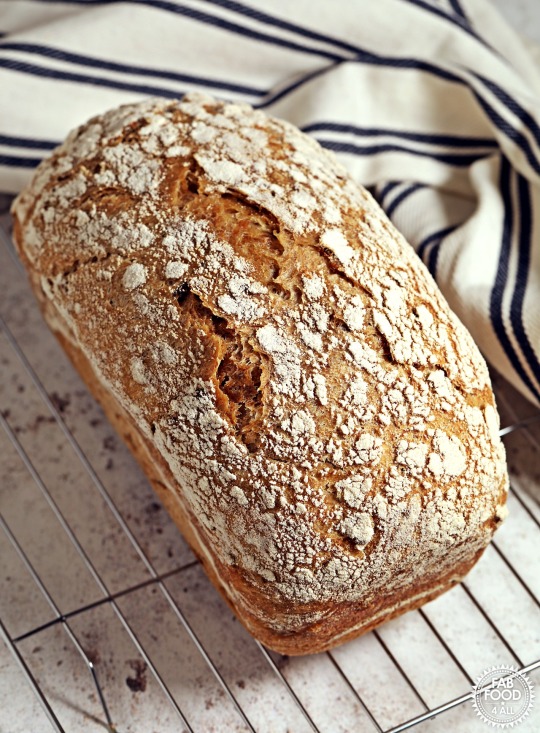
View On WordPress
2 notes
·
View notes
Text
The Irish Porridge Project
We know that cereal grains were in use in pre-Norman Ireland. We also know that yeast baking doesn't work very well in Ireland's climate, such that soda bread is the traditional Irish loaf, rather than the yeast breads and sourdoughs that most other European cuisines have. But bread soda wasn't available in period, so the bread of the medieval era seems mostly to have been flatbreads and some kind of biscuits or crackers, with yeast bread only really available to the rich and in (some) monasteries. Everyone else seems to have gotten along with porridges as the main use for grain. There's even mention of wheat porridges being the appropriate food for royal fosterlings.
"Porridge" in modern English mostly means that it's made from oatmeal, and indeed, it's called just "oatmeal" in some places. But it's possible to make porridge from any grain. The Southern US dish called grits is a maize porridge, for one example. So what I want to do over the next while is try out every kind of porridge that pre-Norman Irish people could have gotten hold of.
There is the issue that we don't actually know what all the grains were. We have a list from the 8th century Bretha Déin Chécht: bread-wheat, rye, spelt-wheat, two-row barley, emmer wheat, six-row barley, and oats, but we don't really know what some of those are, and the translations are dubious in some cases. In this case, I'm going to go for emmer, einkorn, durum, barley, rye and oats. That list may be adjusted if I find more or that some (durum, perhaps) were not available in period. I'll also look at grain-like stuffs like pendulous sedge and fat hen, and see what can be done with those.
Next, there are multiple forms of grain that can make porridge. The full grain "berry", the slightly trimmed groat, various crushed and rolled forms, and coarse and fine flours. In addition, there are malted, roasted, and fermented options for each, and different grains might be mixed. This is adding up to a lot of different porridges!
As I try them, I'll add links here and describe what results I get, including other people's opinions of them, when I get those. I have a couple of co-conspirators on this project, and as they send me the results of their trials, I'll add them here too.
I'd also like to credit Magister Galefridus Peregrinus, whose class in non-baking use of Fertile Crescent grains at Pennsic 50 jumped my initial research and thinking on this particular project by years.
Standard (Rolled) Oatmeal Porridge
Steel-cut Oat Porridge
Fermented Oatmeal Porridge
#irish food#medieval cooking#medieval food#sca#irish medieval food#the porridge project#medieval grains
17 notes
·
View notes
Photo

“Is Your Diet A Thief?” Kingston Whig-Standard. February 15, 1933. Page 10,
---
Is Deficiency The Robber Stealing Your Strength Vigor and Resistance?
---
A diet deficient in certain elements that the human body needs is a thief no less than a hold-up man is a thief For example a diet deficient in Vitamin A robs the body of vigor lowers resistance and makes you more susceptible to catching cold and to other germ diseases.
Chronic fatigue, lack of appetite, unsatisfactory bowel movements, are often symptoms of a deficiency in Vitamin B1.
Underweight in children is frequently caused by a deficiency in B1.
Nutritional anaemia, so common today, is due to a deficiency in iron.
These are only a few examples of the results of deficiencies in diet. But more important to you is the fact that a new product called VIP has been developed after long patient and expensive research to bring to you an increased supply of vital elements in which the ordinary diet is frequently deficient.
Science Turns To "Life Cells” To Overcome Dietary Robberies
To secure the needed elements scientists went to one of the richest known source of Vitamins, Proteins, and Minerals— the life cells of wheat. A life cell, while only a tiny one-hundredth part of a grain of wheat, is its most vital part. It is the embryo from which life springs and which causes the wheat plant to grow. This life cell however has one defect that has restricted its use. When separated from the grain of wheat, it deteriorates, becoming rancid and disagreeable to the taste. This is the reason why it is discarded when milling white flour.
In order to use these life cells of wheat, a special process has been devised that overcomes this defect without destroying or impairing the nutritional value or vitamin content. The manufacturers of VIP are the sole owners of this special patented process.
With these specially processed life cells of wheat are combined cocoa and malt, and an easily-assimilable form of iron, to produce a delightful nut-like food drink packed with vital nutritive elements.
VIP Increases Your Vitamin Supplies
Because of these life cells of wheat, VIP brings to you an increased supply of Vitamin A so necessary to maintain the health of eyes, air passages, lungs, the bladder, and the skin and to maintain bodily vigor and resistance to disease. VIP also brings you a much increased supply of Vitamin B1 which has been proved to have a stimulating effect upon the appetite to invigorate the intestinal tract and to aid digestion.
A third valuable Vitamin in the life cells is Vitamin B which has a beneficial effect on the nerves and digestive organs, while a fourth Vitamin, the life-producing reproductive Vitamin E, without which human life would cease, is richly concentrated in the life cells of wheat.
Children Gain Weight
Research has conclusively proven that Vitamin B1 so richly stored in the wheat life cells, is vitally necessary for children. An adequate supply increase! their rate of growth and weight.
Supplies Energy Builders and your Daily Needs of Iron
In addition to Vitamins VIP brings to you an increased supply of energy-pro-during proteins and minerals stored in the life cells. These have bean amplified with an additional supply of iron for the purpose of enriching the blood and preventing nutritional anaemia. Two teaspoonfuls and preventing nutrition teaspoonfuls of VIP supply 12 milligrams of iron needed by the blood daily.
Add VIP to Your Dally Diet
If you are rundown, nervous, lack of strength and vigor if you have intestinal and digestive disorders as a result of deficiencies in your diet, you cannot start too soon to add VIP to your diet. Even if you are in good health today a deficiency of Vitamins and Iron if continued is bound to store up future trouble for you "Deficiency the Robber” is no less a menace than a "hold up” man.
Delicious Hot or Cold— A Distinctive-Nut-Like Flavor
You'll like your first cup of VIP and your children will drink it eagerly VIP is easy to make Just stir two rounded teaspoonfuls into a glass of hot or cold milk until adding sugar if desired.
While it is a delirious drink HOT or COLD at any time the greatest benefit to you will come from die steady daily use to offset the work of "Deficiency the Robber.”
Obtainable from Druggists
VIP (Vitamins + Iron + Proteins) is obtainable from druggists and department stores in two sizes...
Scientific Feed Products Limited Toronto
McGILLIVRAY BROTHERS LIMITED
Distributors
FLEET STREET TORONTO
#toronto#health drink#vitamin drink#crime and society#crime wave#history of crime and punishment in canada#patent medicine#wheat germ#health cure#iron deficient anemia#iron deficiency#vitamin deficiency#vintage ads#vintage advertising
5 notes
·
View notes
Text
brewing mesopotamian beer, an adventure in parts 2
First step is soaking the grain for the malt, which is toasted sprouting grain.
I had one cup emmer soaking in water for a day, then rinsed it and let it grow while rinsing every 12 hours until it grew sprouts of around 1 cm. It took three days in my kitchen.


I spred it on a baking sheet and baked it in the oven on 150C for 30 minutes, until it turned brownish (if I know it right, baking more makes darker beer)

It smelled really good!
Next step was grinding the grain which I tried in a mortar but failed pathetically; clearly I'd starve to death by myself in the bronze age.
Here's the point where I gave up and put it all to the smoothie maker thingie I have, and whirred it to a coarse semolina texture. A stronger food processor would have been able to make flour out of it which would have been better.

4 notes
·
View notes
Text
So, as someone who's gluten intolerant, I get asked a LOT what foods I can eat.
I've also had people flat out tell me that foods that ARE safe for me to eat, aren't.
So, here's a handy little basic guide for all you people out there who don't know much about this, but are curious:
What Is Gluten?
Gluten is the name of a group of proteins often found in wheat, and some other grains. It's also the thing that makes your bread stick together and give that bready goodness, and help your foods stick together, like a kind of glue.
Foods That Contain Gluten:
Wheat
Wheat varieties and products like spelt, durum, semolina, couscous, farina, farrow, kamut, einekorn, wheat bran, wheat germ, emmer, seitan
Rye
Barley
Triticale
Malts (From barley)
Anything made with flour from the above grains.
Alcoholic beverages made with the above grains. (Most distilled drinks are fine, however, but that needs to be checked out on a case by case basis)
Crumbed and battered foods with the above grains.
Yeast, depending on source.
Foods That DON'T Contain Gluten:
Fresh fruits and vegetables.
Potatoes
Beans, seeds, legumes and nuts that are unprocessed.
Rice
Amaranth
Arrowroot
Buckwheat
Corn — cornmeal, grits and polenta labeled gluten-free
Flax
Hominy (corn)
Millet
Quinoa
Rice
Sorghum
Soy
Tapioca (cassava root)
Teff
Unprocessed meats. Like steak, chicken, pork...
Bacon.
Milk.
Foods That May Cause A Reaction:
Oats.
Yep, oats, while in themselves gluten free, (and apart from cross contamination issues, which can occur with all the above grains), have a protein called Avenin, which is similar to gluten, and can cause a reaction in some people like gluten would.
Seems easy enough to get around, right?
Wrong.
Remember I said above gluten acts like a glue?
Wheat flour is cheap.
Wheat flour is a very common thickener. I've personally seen it in ice cream, soups, stews, even soy sauce.
It's also used in a lot of corn or rice products, like crackers, tortillas, corn chips, noodles (yes, I've seen it in rice noodles), and sometimes the seasoning on potato chips. (There is nothing more infuriating than finding rice noodles containing wheat. It's just cost cutting, and stupid.)
Some of these products don't need wheat flour to hold them together, but wheat is cheap, and can bulk out other foods. It can also make sauces look better, and give a nice texture.
It's used in a lot of packet gravy mixes.
Barley is a commonly used flavouring. I've seen it in soups, stews, chocolate...
Yeasts can also contain wheat traces.
Even foods that don't have wheat as an ingredient, can contain traces.
A lot of processed foods have wheat in them. Again, cheap and glue.
Glucose syrup can be gluten free, depending on the source.
So basically, I have to read every label. Some products are gluten free, and then the company decides nah, and doesn't change the label (This has happened to me). Thankfully a lot of gluten free products label as such, so if you've seen foods you're sure are gluten free labelled that way, this is why. It encourages gluten free people to buy it, and the buyer doesn't have to read every freaking list of ingredients. Which is exhausting.
Things I've Had Ignorant People Argue With Me Over
You didn't think I was going to make a post like this without some humour in it, did you? Of course not! So here's the dishonour list, of conversations I've had.
"All potato chips contain gluten."
"Not the ones marked."
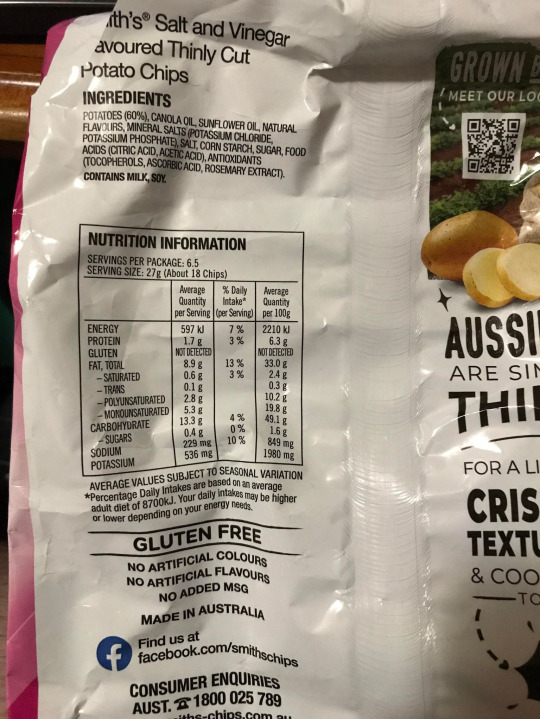
"Are you sure?"
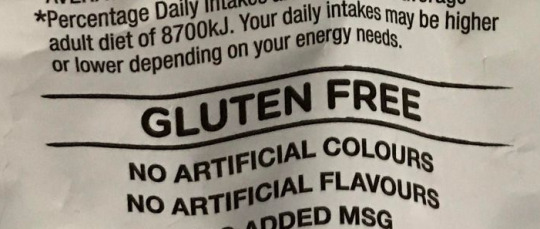
"What if they're just saying it?"
"They won't."
"Are you sure?"
"They'd get fined and/or sued. All allergens have to be listed by law."
"Rice isn't gluten free."
"Yeah it is."
"Nope, all grains contain gluten."
"Not all grains. Trust me, rice is gluten free."
"No, it isn't."
"Ok, I've researched the shit out of this, are you telling me I'm wrong?"
"Rice isn't gluten free."

"Oh."
"Yeah. Listen to me next time."
"Are you sure that avocado is gluten free?"
-blinking in astonishment- "Yes."
"You're sure?"
"Yes!" -pause- "Do you want me to google it for you?"
"No, I'm good."
"Vegemite is gluten free, they don't need to bring a gluten free version out."
"It's the yeast."
"They're just doing it to charge more."
"...They're the same price..."
"Yeast is gluten free though."
-three linked articles later-
"Oh. Why did you just tell me that?"
"Because you were arguing with me again, and it's more fun this way."
"Gluten free is healthier."
-extended laughter- "Nope. There's a lot of additions to try and mimic what gluten does."
"But it's all natural ingredients."
"Where did you hear that?"
"Everyone knows it. Because gluten free people like to be healthier."
"Trust me, it's not true."
"Everyone says gluten free is healthier."
"They're full of bullshit."
Sources for this post:
5 notes
·
View notes
Text
Gluten-free food options
Ever wondered if that ice-cold Coco-Cola you were eying up is gluten-free? Ever wanted to know if pizza and pasta are gluten-free? How about your favorite cheeseburger and fries? How about the Vodka and Beer? Whatever it is that you are looking for, we got you covered in this list of gluten-free foods.
A gluten-free foods list can be a valuable resource. You have been spending hours and hours navigating stores and restaurants to find gluten-free food options and it may be really challenging at times. Therefore on hand, the gluten-free foods list below might help you know what to look for (and what to look out for) when choosing grains and other foods that may contain gluten.
Below are a few things to look out for when you're buying gluten-free foods.
1. Gluten-Free Whole Grains: Oats, Cereals, Bread, and More…
Grains (including bread, pasta, rice, and crackers), specifically whole grains, are an important part of a healthy diet. Whole grains are a good source of healthy carbohydrates, providing energy to get you through the day. Most whole grains are high in fiber, which keeps you full and helps with digestion. Though many grains have gluten, a wide variety is naturally gluten-free.
Naturally Gluten-Free Grains & Starches:
Rice
Quinoa
Millet
Oats (use oats labeled "gluten-free," as oats are often cross-contaminated with wheat and barley.)
Cassava/Yuca
Sorghum
Teff
Corn
Buckwheat
Amaranth
Potatoes and potato flour
2. Gluten-Free Vegetables & Fruits
All fresh, whole vegetables and fruits are naturally gluten-free and important to include in a gluten-free diet.
Organic local produce mostly delivers a variety of vitamins, minerals, and antioxidants. However, you need to look out for sneaky gluten once you move out of the produce aisle. Plain fresh and frozen (without sauce) vegetables are all gluten-free, but make sure to double-check ingredient lists on packages to be sure.
When buying canned veggies, buy those packed with water or natural juices (typically the healthier option anyway). Here's what to look out for when selecting gluten-free fruit and vegetables.
What to Avoid When Shopping for Fruits and Vegetables:
Hydrolyzed wheat protein
Modified food starch: Check the label if it does not specify what type of starch is used, and check with the manufacturer, as it may be wheat.
Malt: Including malt syrup, malt vinegar, malt extract, malt flavoring
Gluten stabilizer
Maltodextrin: This is OK when made from corn, potato, or rice starch. If it is made from wheat, it will be labeled: you may have a reaction, though many claim the gluten is destroyed in processing.
Safe Ingredients:
Corn-starch
Potato starch/potato starch flour
Distilled vinegar
Mono- and diglycerides
Oat gum
Citric acid, lactic acid, and malic acid
3. Gluten-Free Proteins
Most protein sources-both animal and vegetable proteins-are naturally gluten-free. You may use the below list to help you decide which proteins can fit into a gluten-free diet.
Naturally Gluten-Free Proteins:
Red meat: Fresh beef, pork, lamb, goat, bison, duck, etc. (Avoid marinades as if gluten is added it might sneak into your meat)
Poultry: Fresh chicken and turkey (Check if any marination is added)
Seafood: Fresh fish, scallops, lobster, clams and more are all naturally gluten-free. (Check if any marination is added)
Tofu: It's made from soy, which is gluten-free, but check for any additional ingredients with gluten.
Beans
Nuts and seeds
Proteins That Need a Second Look:
Processed meats: Including hot dogs, pepperoni, sausage, etc. These may have gluten added, so be sure to check the ingredient list and avoid those with wheat gluten, wheat starch, or wheat dextrin.
Cold cuts: Cross-contamination can also happen at the deli on the meat slicer. Cold cuts may have gluten-containing ingredients added
Ground meat: Ground beef or ground turkey can have gluten added in as filler. Be sure to check the ingredients carefully.
Veggie burgers and other meat substitutes: Some flavors and brands are made with ingredients that contain gluten-check the labels.
4. Gluten-Free Sauces, Spices, and Condiments
In many common condiments, gluten-containing ingredients can be used as thickeners, stabilizers, or flavor enhancers. Wheat flour is a common thickener in many sauces and marinades, which means they contain gluten. Look out for cross-contamination once these items are in your home. For example, a knife that spreads mustard on wheat bread shouldn't be dipped back into the mustard jar if you want it to stay gluten-free.
Sauces, Spices, and Condiments That Are Usually Safe:
Mustard: Some specialty or flavored mustards may contain gluten so always check the ingredients.
Mayonnaise: Check the ingredients to be sure though typically not made with gluten.
Dry spices: Single-ingredient herbs and spices (think dried basil, garlic powder, chili powder) do not contain gluten, though because of cross-contamination concerns it's best to look for specifically labeled gluten-free spices or check with the manufacturer.
Sauces, Spices, and Condiments That Need a Second Look:
Ketchup and Worcestershire sauce: Both condiments can be made using malt vinegar, which is not gluten-free. Double-check the ingredients.
Barbecue sauce: Avoid BBQ sauces made with barley-based beer, soy sauce, malt vinegar, and barley malt flour as these typically contain gluten.
Soy sauce: Soy sauce is traditionally made with wheat, so it usually is not gluten-free unless otherwise marked.
Malt vinegar: Malt vinegar is mostly found in some salad dressings and sauces and it's not gluten-free. However, white vinegar, distilled vinegar, and apple cider vinegar are all gluten-free.
5. Gluten-Free Desserts & Sweets
Many sweets and desserts are made with wheat flour or other ingredients with gluten. Be mindful that gluten-free sweets are not necessarily healthier for you than regular treats but they might prevent a bad reaction if you are sensitive to gluten.
Sweets That Are Usually Safe:
Chocolate: Chocolate does not naturally contain gluten. There is also a risk of cross-contamination, so it's best to check the label on the chocolate.
Hard candy and gummies: Candies don’t usually contain gluten; avoid those listing "wheat flour" as an ingredient.
Ice cream, sherbet, gelato, frozen yogurt: These treats are generally gluten-free, but steer clear of those with pretzels, cookie dough, graham crackers, brownie bites, and other gluten-containing add-ins.
Sweets to Avoid:
Grain-based desserts: Cookies, cakes, brownies, pies, doughnuts, pastries, cheesecake, etc. are almost always made with gluten unless marked "gluten-free."
Licorice: Sweet candy may be made with wheat flour and therefore is not gluten-free unless otherwise noted on the packaging.
Barley malt: Avoid sweets made with this ingredient, which is used to sweeten some candies and chocolates.
6. Gluten-Free Drinks and Beverages
Water, of course, is naturally gluten-free and is your best healthy way to stay hydrated. For all prepared beverages, be sure to check the ingredients, as variations and blends may contain gluten.
Drinks and Beverages That Are Usually Safe:
• Coffee and tea: These beverages are both naturally gluten-free, but if you're sensitive to gluten it's best to check and make sure there was no cross-contamination with your coffee beans or tea leaves or added ingredients in blended beverages.
• Juices, sodas, and sports drinks: Check the label to be safe, but these generally won't have added gluten-containing ingredients
5 notes
·
View notes
Text
Read Gluten-Free Labels Before Buying Food Products

Have you ever been to a store for buying groceries or food items and checked the food labels? Reading food labels is very important to check before buying food products especially if you are celiac, gluten intolerant, or sensitive to gluten. Most of the time people only give importance to the expiry dates and overlook gluten-free labels.
Importance of Labelling of Gluten-Free Food
It is no surprise that the production, sale, and consumption of pre-packaged foods have increased exponentially over the years.
The role of food labeling in food safety is indispensable. In addition to helping consumers make informed choices about the products they buy, these labels also guide them in safely using the food products.
Largely considered to be a direct source of product information between the buyer and the seller, food labels help consumers make mindful, informed, and healthy food choices.
While proper food labels benefit everyone, people with food allergies rely especially heavily on the clear and accurate labeling of their food products.
Many studies have been conducted to assess the current status of health in India, and the root causes of these issues as they pertain to diet and lifestyle choices.
What is Gluten?
The first question that comes to mind after being diagnosed with celiac is what gluten-free means and how it affects celiac people.
gluten is the main storage protein that is naturally located in specific grains like barley, wheat, and rye.
In the food industry gluten provide elasticity and stretches which allow the bread to rise and soak moisture.
Due to its frequent properties and gluten is widely used in the food process industry to provide instant texture and enhance moisture retention.
Gluten has been known by different names and terms. Some gluten-free items are listed under various names or scientific terms.
Following are the scientific terms that are used for wheat, barley, and rye. If you see any ingredient on the packaging you can have the idea that a particular product contains gluten.
Secale cereale: Rye
Triticum spelta: Type of wheat
Triticale: Cross between wheat and rye
Triticum Vulgare: Wheat
Hordeum vulgare: Barley
How can you tell if something is gluten-free?
Alternative Names for Gluten
→Gluten-Free Label: If you see the gluten-free sign on the product then it is more likely safe to eat and gluten-free.
However, you should always check the ingredients list on the package to make sure that the product is gluten-free and safe to eat. It is also important to keep in mind that some products are written as “wheat-free” which does not necessarily mean that are “gluten-free”.
→Check the Allergen Listing: Check the Ingredients on the package: Some products’ ingredient lists contain allergens including soy, wheat, egg, nuts, and milk which necessarily does not mean that it is gluten-free.
→ Check Gluten Obvious Ingredients on the Package: Following are the gluten ingredients you need to check before purchasing packages of food:
Barley
Wheat
Malt
Rye
Yeast
Oats (unless labeled as gluten-free)
If you see the gluten-free sign on the product always check the ingredient on the package and read the ingredient list thoroughly if there is any hidden ingredient available there is a possibility that it has contained gluten.
Ingredients That Always Contain Gluten
Following are the foods which mostly contain gluten and you should avoid:
Bread and Pastries
Noodles
Flour Tortillas
Sauces and Gravies
Brewer yeast
Beer
Malt vinegar
Wheat flour
Baked goods
Cereals and granola
pancakes, waffles, french toast, crepes, and biscuits.
Crackers
Ingredients That May Contain Gluten
Cheesecake fillings
Brown rice syrup
Soy sauce
Self-basting poultry
Energy bar or Granola bar
Potato Chips
Soup
Candy and candy bars
Processed lunch meats
Salad dressings and marinades
Egg served at restaurants
Pre-seasoned meats
Multigrain chips or tortillas
French fries
Ales
Communion Waters
Croutons
Roux
Supplements
Play Dough
Seafood

Tips for Gluten-Free Label Reading
If you are someone who has been diagnosed with a food allergy, reading labels might seem incredibly daunting. Spending some time learning about your specific sensitivity and the many ways in which they may be listed on food products goes a long way.
When reading food labels in India, pay attention to the following:
→Check the third-party certification
If a product has third-party certification like Gluten-Free Certification Organisation (GFCO) it is more likely to be safe for celiac patients and gluten-free.
→Check the gluten-free label on products
Whenever you go to a store or buy a packaged food product always check the gluten-free label on that product. If a product has a gluten-free label it is more likely safe to eat. However, make sure that you check the ingredients on the packaging as well.
→Serving Size
Always make to check the serving size to know how much you are consuming relative to the suggested quantity, as we often tend to consume more than one serving size.
→Nutritive Value
The nutritive value of a product includes metrics, such as calories, proteins, carbohydrates, fats, and vitamins, as well as the presence of saturated and unsaturated fatty acids, cholesterol, calcium, sodium, etc. Consume a product only if it suits your dietary requirements.
→Important Details
If you have a history of being allergic to a particular ingredient, look for its presence on the ingredients list so that you do not develop an allergic reaction upon consumption. Other important details such as the expiry date should not be ignored either.
→Colors and Preservatives
Don’t forget to check the label for any kind of preservatives, such as artificial food coloring, since they could trigger an allergic reaction in highly sensitive individuals.
Some other facts you should know:
Calories are mentioned in terms of energy.
Check the micronutrients section for the presence of vitamins and minerals in the food product.
Nutrients such as carbs, proteins, and fats are listed in descending order on the food label.
Ingredients are also listed in descending order. This is where you are likely to find all the information regarding an allergen or additives as well.
FDA’s Regulation of “Gluten-Free” Claims
A Disease Burden Study report, “India: Health of the Nation’s States” conducted by the Indian Council of Medical Research revealed some shocking statistics.
The report stated that “death due to non-communicable disease (NCD) has proportionally increased from 37.09% in 1990 to 61.8% in 2016”.
According to another National Family, Health Survey conducted in the year 2015-2016, “11% of women (1 in 10) and 15% of men (1 in 7) age 15-49 are hypertensive, and about 60.4% of people screened have never had their blood pressure measured”.
One of the most noteworthy measures introduced to mitigate these bleak trends is the Eat Right Movement, initiated on July 10th, 2018, focusing on spreading awareness among businesses and consumers and creating a “new food culture” that promoted the inclusion of healthy foods in our daily meals.
This data indicates that one of India’s most significant risk factors for poor health in 2016 was the result of dietary choices, specifically, the consumption of a diet low in fruits, vegetables, and whole grains, and one high in salt, sugar, and fat.
Evidently, well-illustrated food labels grew in importance and began to help consumers choose healthier alternatives.
Food labeling is of crucial importance in India, yet several small manufacturers leverage the lack of strict FSSAI regulations to mislead their consumers.

Hence, we must understand the extent to which accidental consumption of even a small number of allergens by an individual with a food allergy can pose life-threatening risks to their health.
Current FSSAI regulations require all product manufacturers and brands to follow a not-so-comprehensive set of guidelines that impose the following twelve primary labeling regulations for food packaging:
Name of the food
The list of ingredients
Nutritional information
Declaration if the food product is vegetarian or not
Declaration of the food additives used
Name and complete address of the manufacturer
Customer care details
Quantity
Retail sale price
FSSAI logo and license number
Batch identification number, the date of marketing, country of origin
Instructions for use
Most consumers with food allergies suffer due to the lack of information about potential allergens in food items.
Finally responding to the advocacy of informed consumers, several brands in India are working on making their product labels inclusive of nutrients, allergen warnings, and more.
Products Covered by the Gluten-Free Regulation
Thanks to people who have voiced their concerns regarding current manufacturer practices, the Food Safety and Standards Authority of India (FSSAI) has finally decided to come up with labeling of allergens as well as gluten-free products.
An amendment of the FSSAI Regulations, released in 2016, incorrectly defined gluten-free food as food that “consists of oAn amendment of the FSSAI Regulations, released in 2016, incorrectly defined gluten-free food as food that “consists of or is made of one or more ingredients containing millets, pulses, ragi, rice, or legumes”.
Further, for any food item to be qualified and labeled as gluten-free, the gluten levels in the product needed to be less than 20 mg per kg.
Individuals with celiac disease must avoid gluten entirely, for even the slightest ingestion of gluten can elicit allergic symptoms. Thus, better labeling practices are of pressing urgency to prevent even more suffering in the Indian gluten-free community.
FDA rules and regulations are applied to all Food and beverages including Processed food, packaged food, dietary supplements, fruits, and vegetables.
→ There are some the exceptions like poultry, meat, and certain foods.
→ Alcohol beverages are regulated by Alcohol and Tobacco Tax and Trade Bureau (TTB)
Conclusion
Individuals with celiac disease must avoid gluten entirely, for even the slightest ingestion of gluten can elicit allergic symptoms. Thus, better labeling practices are of pressing urgency to prevent even more suffering in the Indian gluten-free community.
It is always recommended for celiac or gluten intolerant patients to check the label on food packaging to make sure that food is gluten-free and safe to eat.
Source: The blog is originally published here
3 notes
·
View notes
Text
Moderate Yin and Yang Food That Will Keep You Fit And Healthy
If you balance your diet with moderate-energy foods, you can easily keep your body and mind healthy. Avoid extreme yin and yang foods and have these moderate foods.

Hello, I'm Hiroyuki Naka, a macrobiotic mentor.

Last time I listed some foods with extreme yin and yang qualities that are difficult to balance. Here are some moderate-energy foods to balance your diet to achieve health and freedom.
These moderate energy foods are relatively easy to balance and can be divided into moderate yin and moderate yang.
If you’re sick, suffering from a cold, or the COVID-19 that’s currently sweeping the world, and you’re feeling physically drained, you should choose what to eat from these moderate yin foods or moderate yang foods I'm going to show you.
Let’s begin with grains.
Moderate yin grains are sprouted brown rice, green rice, oatmeal, sorghum, couscous, job’s tears, pressed barley, whole barley, whole wheat flour, whole wheat udon noodle, whole wheat somen noodle, corn, and polenta.

Moderate yang grains include brown rice, red rice, black rice, whole buckwheat, barnyard millet, foxtail millet, common millet, quinoa, amaranthus, glutenous brown rice, whole wheat pasta, 100% buckwheat noodle, and whole wheat natural yeast bread.

Next, vegetables.
Moderate yin vegetables are leaf vegetables such as Japanese mustard spinach, edible chrysanthemum, pak choi, Chinese cabbage, tah tsai, okahijiki (Salsola komarovii), Mitsuba (Japanese parsley), Daikon leaf, radish, wasabi leaf, turnip leaf, Seri (Japanese parsley), watercress, Mizuna greens, mustard leaf, and rape leaf.
White leek, parsley, celery, broccoli, and cucumber.
Snap peas, green peas, green beans. Sprouts such as bean sprouts, radish sprouts, and alfalfa sprouts. Lettuce.

Edible wild plants come out in spring such as Fuki-noto (Japanese butterbur), and bamboo shoots.

Mushrooms such as dried shiitake mushroom, fresh shiitake mushroom, shimeji mushroom, maitake mushroom, enoki mushroom, matsutake mushroom, nameko mushroom, and mushroom.
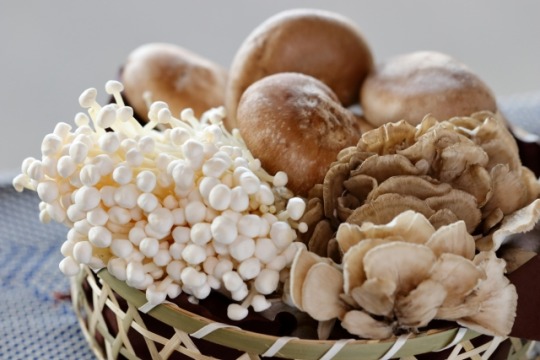
Taro, konnyaku, horse radish, and ginger.
Seeds and nuts such as almonds, peanuts, sunflower seeds, walnut, and ginkgo nut are moderate yin.

Moderate yang vegetables are root vegetables such as burdock, lotus root, carrot, daikon radish, dried strips of daikon radish, Japanese yam, and turnip. Round vegetables such as cabbage, Brussels sprouts, cauliflower, pumpkin, and onion.
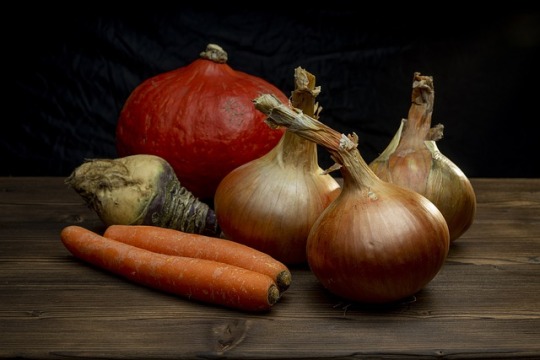
Chestnut, sesame seed, pumpkin seed, and Yoshino kudzu are moderate yang.
Moderate yin beans are soybean, natto, tempeh, tofu, pinto bean, fava bean, chickpea, kidney bean, mung bean, edamame (young soybean), and soybean product such as fried tofu, soy milk, and okara (soy pulp).

Moderate yang beans are lentil, azuki, black soybean, and Koya-tofu (freeze-dried tofu).
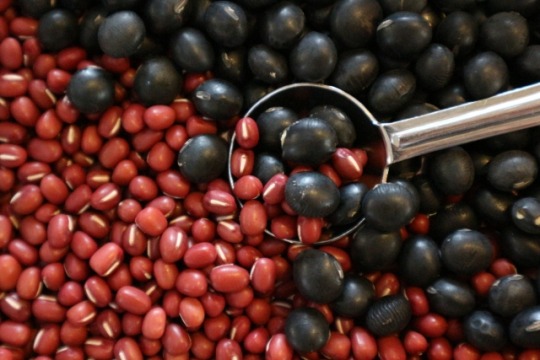
Moderate yin seaweeds are nori, aonori, mozuku, agar, wakame, mekabu, and mehibi.
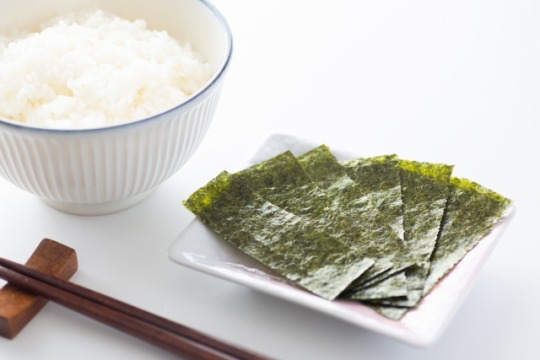
Moderate yang seaweeds are hijiki, arame, and kelp.
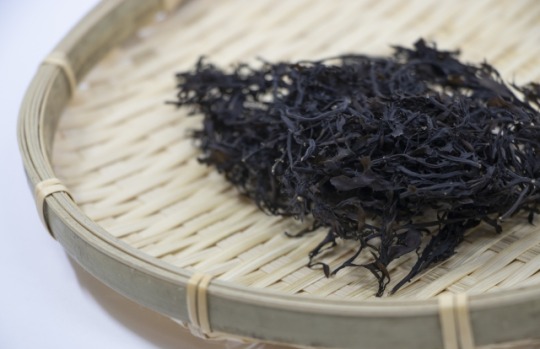
Next, fruit.
Moderate yin fruits are tangerine, orange, lemon, peach, Japanese pear, pear, melon, watermelon, grape, and persimmon.

Moderate yang fruits are apple, berries such as strawberry, blueberry, raspberry, cranberry, and blackberry, and dried fruit such as raisin and cherry.

As for seasonings, white miso, vinegar, barley miso, rape seed oil, olive oil, and corn oil are moderate yin.

Natural sea salt, blended miso, rice miso, soybean miso, soy sauce, plum vinegar, and sesame oil are moderate yang.

Moderate yin condiments good to eat brown rice with are perilla condiment, wakame condiment, and aonori condiment.
Gomashio (salt with sesame) and tekka miso are moderate yang.
Among pickles, Bettara-zuke, Nara-zuke, Nozawana-zuke, Asa-zuke, sweet ginger pickles, and German salt pickled cabbage Sauerkraut are relatively yin.
Takuan, Nuka-zuke (typical Japanese pickles made of fermented rice bran), Furu-zuke, and Umeboshi (pickled salty plum) are yang.
Among sweeteners, brown rice amazake, beet sugar, maple syrup, and apple juice are yin, and rice malt syrup is yang. Raisins are used as sweetener occasionally which is yang.
As for tea, Mugi-cha (roasted barley tea) drunk often in the summertime in Japan, green tea and herbal tea are yin.

Hoji-cha, San-nen-bancha, Kuki-cha (green tea mainly uses stems instead of leaves), roasted grain beverage are yang, and dandelion coffee (roasted dandelion root) is very yang.

And animal-derived foods of moderate energy compared to the extreme yang animal-derived foods I mentioned former are white-fleshed fish such as sea bass, flatfish, flounder, sillago, sea bream, cod, and tilefish, and river fish such as carp, crucian carp, sweetfish, trout, and rockfish, and shellfish such as Japanese clam, oyster, abalone, and turban shell.

Those foods of moderate energy are relatively easy to balance, but if you continue to eat the same food as it is said to be good for health, you’ll get biased yin or yang anyways which leads to sickness or illness.
To avoid that, when you eat yin food, it is necessary to prepare yang food to make balance, and vice versa is right.
_______________
Originally distributed by Hiroyuki Naka, a macrobiotic mentor, as an E-mail newsletter in Japanese on Feb 8th 2022.
Translated by Meerabai
_______________
"What Is the Difference Between People Who Are Infected With COVID-19 And Those Who Are Not?"
Hiroyuki Naka, a macrobiotic mentor explains the difference through the yin-yang theory.
A-must-see YouTube video by Hiroyuki Naka.
youtube
English subtitle coming soon!
#Moderate yin and yang foods#macrobiotics#the Order of the Universe#healthy diet#Hiroyuki Naka#Michio Kushi#yin and yang
3 notes
·
View notes
Text

⚠️Contains Spoilers!!!⚠️
The Old Grist Mill
youtube
I'm just going to go ahead and link this song because in my opinion it is one of the best songs in the whole series period.
I love how the beginning of the series makes no sense to first-time watchers but after you have watched it at least once, everything at the beginning of the first episode makes sense. It gives off the same vibes as Jojo's Bizzare Adventure's openings...
The Tome of the Unknown style is in every single title screen and it makes me so aesthetically happy. It intensifies the melancholy-autumn mood that this whole show embodies and of course, the art style is just amazing. I don't think any other art style would fit this series better than this one.
Can we just pause for a second and talk about how f*cking cool it is that this entire show is just one big circle? The opening scene when the narrator starts talking is Wirt falling into the frozen pond... How do people come up with stuff like this!? I wish more series/movies did this kind of stuff. It just opens the door to so many more theories and expands the lore just that much deeper.
Also before this episode gets any further in I just want to mention:
grist;
grain that is ground to make flour.
malt crushed to make mash for brewing.
2.useful material, especially to back up an argument.
grist for the mill — useful experience, material, or knowledge.
I just found it interesting that the episode is named after it ヾ(^∇^)
Beatrice is one of my favorite characters in this show besides the Frog. The name Beatrice has many meanings but the one I think that makes sense in relation to the storyline is the one from the bible: deriving from the Latin word Beatrix meaning "One who blesses others". We'll talk about her more later because she is definitely a very important character in the series and the amount of lore is just *french kiss*.
I'm ashamed to admit that I missed this the first time around but it's now so funny to me that while Wirt is wallowing in his sorrows and talking versing poetry about his life- Greg is just in the background swinging around objects to see which one he could knock out the woodsman with the best.
I love rock facts. 〔´∇`〕
🍬 The candy trail that Greg has and produces out of his pants that ultimately "leads the beast' to them (Wirt and Greg) could be taken as a metaphor for no good deeds go unpunished- or that all good things lead to the bad. The 'beast', or the bad in OTGW is led to the mill by Greg's candy trail that was supposed to lead Wirt and Greg back out of the Unknown.
One of my favorite lines from the show is when Greg sees the 'beast' and says "You have beautiful eyes". Greg always looks for the good throughout the series and that makes me happy (^v^)
🐢 The Black Turtles ~
These guys show up everywhere. I recommend you read the short article about them from the wiki that you can find here. I love these things. They're so mysterious, rare, and never explained. It never is even explained why Wirt says later in the series to Auntie Whispers that he "came to burgle her turts!". Does Wirt know something to do with the turtles that the watcher doesn't or is he just being observant and trying to make up an excuse on the fly? (More about that later in the series) It's such a good example of an uncanny valley~ they are turtles but they're black..? Black turtles don't exist in real life** and the ones in OTGW seem either to be just a singular turtle (although its never specified ).
** I kind of went down the Wikipedia rabbit hole and found out that "black" turtles do exist. Okay, so they're not entirely black but they are at least darker in color than your average sea turtle. Even farther down the rabbit hole, I started to find some things about Chinese Astrology and what certain constellations mean to them. The one that I found is the most 'relevant' (a.k.a I think it just matches the theme of OTGW the best).
This is kind of complicated because of course, everything is disputed because legends and myths are always disputed so I'll try to explain this in the least confusing way possible:
So the moon travels around the earth in a total of 27.32 days. Scientists track this progress by calculating the longitudes along the orbit (called an ecliptic) and then split it up into 28 different segments called Mansions or Stations (and sometimes even houses for some reason?). Anyways, ost often these were used by ancient cultures as part of their calendar systems. One of these cultures is ancient China.
There's more... "The 28 Lunar Mansions are divided into four clusters, with each cluster made up of seven constellations"...
There's a lot of math involved in all of this and I'm not an astronomer so I'm not sure how all of these connect but anyways I will put a pretty picture to kind of give you an idea of what I'm talking about here.
Now... how does this connect to OTGW? Well, 2 things:
1. All of these Moon Stations make up "The Black Tortise of Winter" which according to this Wikipedia passage states that the Black Tortise corresponds to astrology and traveling to the underworld to guide people.
2. The 11th Moon Station of the "Black Tortoise of Winter" has a Chinese character meaning Emptiness. (pictured below)


I think that all of this concentrated around emptiness and the underworld largely reflects the ideas of the Unknown in OTGW. The Unknown is like a different world where people who are lost go to never be seen again. Kind of like Hell or the underworld. It's vast and has very few inhabitants. The turtles showing up in the movie could be almost like a guiding figure.
I appreciate the fact that the 'beast' in the beginning is Beatrice's dog. I just love dogs and that little extra added touch for the whole full-circle vibe of this show just makes me happy.
"Aint that just the way"
Burdens and burdens that are needed of bearing are mentioned in this episode and then never again but I still want to acknowledge that the Woodsman kind of predicts that Wirt will take on most of the problems in this show following this episode. Taking the blame, solving problems, etc., etc. which is most likely the reason why he gets turned into an adle wood tree first before ultimately Greg does. Kind of a statement piece on how difficult it is being an older child and looking after your younger siblings. This whole sentiment of "oh, your younger sibling is too young and doesn't understand, and therefore shouldn't get blamed" really can affect the elder sibling and like Wirt in the end, make them lose hope over time. Getting blamed for other people's problems is a tough situation and I think that way too many eldest children get put in the same boat. Especially at younger ages, this can cause severe problems later on down the line.
I love the frog.
I also love this drawing by @wabidrawbi

keep drawing friends. you're doing amazing <3
XOXO
#Youtube#over the garden wall#otgw#otgw aesthetic#greg otgw#otgw wirt#otgw spoilers#otgw fanart#wirt#greg#otgwfan#otgw beatrice
6 notes
·
View notes
Text
Malt Ingredients Market Projections: Global Industry Analysis and Forecast (2023-2032)

The global demand for Malt Ingredients was valued at USD 26,154.20 Million in 2023 and is expected to reach USD 324,773.09 Million in 2032, growing at a CAGR of 32.30% between 2024 and 2032.
The malt ingredients market involves the production, distribution, and utilization of malt and malt-derived products used primarily in the food and beverage industry. Malt is produced by germinating cereal grains, typically barley, and then drying them in a process called malting. Malt ingredients are crucial in brewing beer, distilling spirits, and producing malt vinegar, malted milk, and various bakery products. The market is driven by the increasing consumption of alcoholic beverages, especially craft beers, and the rising demand for natural and organic food ingredients. Key trends include the development of specialty malts with unique flavors and colors, the use of malt in health and wellness products due to its nutritional benefits, and innovations in malt extraction processes to enhance quality and efficiency. The market faces challenges such as fluctuations in raw material prices and the need for sustainable production practices. Overall, the malt ingredients market is expanding due to its wide range of applications and the growing popularity of malt-based products.
Malt flour, produced by grinding malted grains, is added to dough to improve texture and fermentation, contributing to the rise and softness of the final baked product. The rich, sweet flavor of malt also makes it a popular ingredient in milkshakes, malted milk drinks, and various desserts.
Nutritionally, malt ingredients offer several benefits. They are a good source of essential vitamins and minerals, including B vitamins, iron, and magnesium. Malt is also rich in dietary fiber, which aids in digestion and promotes a feeling of fullness. The presence of antioxidants in malted grains can help reduce oxidative stress and contribute to overall health.
The versatility of malt ingredients extends to their functional properties in food processing. They act as natural preservatives, extending the shelf life of products without the need for artificial additives. The enzymes in malt can improve the texture and volume of baked goods, making them softer and more appealing. Additionally, malted ingredients can enhance the color of food products, providing a natural golden hue that is particularly desirable in baked goods and cereals.
Malt Ingredients Types:
Malted Barley:
Primary ingredient used in brewing and distilling.
Provides enzymes, fermentable sugars, and flavor.
Malted Wheat
Used in brewing wheat beers and in baking for improved dough characteristics.
Contributes to a lighter color and distinct flavor profile.
Malted Rye:
Adds a spicy, robust flavor to beers and spirits.
Often used in specialty breads and rye whiskey production.
Malt Extracts:
Liquid or dried form of malted barley.
Used in baking, brewing, and confectionery for sweetness and flavor enhancement.
Malted Oats:
Adds creaminess and smooth texture to beers and baked goods.
Enhances mouthfeel and body.
Malt Flours:
Finely ground malted grains.
Used in baking to improve texture, flavor, and shelf life of products.
Specialty Malts:
Caramel or crystal malts: Adds sweetness and color to beers.
Roasted malts: Impart deep color and rich, roasted flavors.
Key Players-
Cargill Incorporated
Ireks GmbH
Dohler GmbH
Malteurop Group
Simpsons Malt Limited
Axereal (BOORTMALT NV)
The Soufflet Group
Barmalt India Pvt. Ltd.
Viking Malt Oy
Vivescia Industries SCA
Polttimo Oy
Malt Products Corporation
Muntons Plc.
Crisp Malting Group
Holland Malt B.V.
Malt Ingredients Market Drivers
Increasing Consumption of Alcoholic Beverages:
Growth in the global beer industry, especially the craft beer segment, drives the demand for malt ingredients.
Rising popularity of whiskey, vodka, and other malt-based spirits.
Health and Wellness Trends:
Growing consumer awareness about the nutritional benefits of malt ingredients, including vitamins, minerals, and antioxidants.
Increased use of malt in health supplements, sports drinks, and functional foods.
Natural and Organic Product Demand:
Shift towards natural and organic ingredients in food and beverages.
Consumer preference for clean-label products free from artificial additives and preservatives.
Innovation in Food and Beverage Products:
Development of new and innovative malt-based products, including malted milk, malted vinegar, and specialty malts with unique flavors and colors.
Use of malt ingredients in a wide range of applications, from bakery products to confectionery and dairy.
Expansion of the Baking Industry:
Growing bakery industry increases demand for malt ingredients that improve texture, flavor, and shelf life of baked goods.
Use of malt extracts and flours in artisanal and specialty breads.
Rising Popularity of Gluten-Free Products:
Demand for gluten-free malt ingredients, such as malted rice and sorghum, due to increasing prevalence of gluten intolerance and celiac disease.
Expansion of gluten-free product lines in brewing and baking industries.
Technological Advancements in Malting Processes:
Innovations in malting technology to enhance the quality, efficiency, and sustainability of malt production.
Development of specialized malts with enhanced enzymatic activity and specific flavor profiles.
Growing Demand in Emerging Markets:
Increasing disposable incomes and changing lifestyles in emerging markets, leading to higher consumption of malt-based beverages and foods.
Expansion of brewing and baking industries in regions such as Asia-Pacific and Latin America.
Sustainability and Ethical Sourcing:
Emphasis on sustainable and ethical sourcing of raw materials for malt production.
Adoption of environmentally friendly practices in the malting process to reduce carbon footprint and waste.
More About Report- https://www.credenceresearch.com/report/malt-ingredients-market
Malt Ingredients Market Key Findings of Study
Market Growth:
The malt ingredients market is experiencing steady growth, driven by the increasing consumption of alcoholic beverages, especially craft beer and spirits.
The market is projected to grow at a significant CAGR over the next few years.
Dominant Segment:
Barley remains the dominant source of malt, accounting for the largest share of the market.
Specialty malts are gaining popularity due to their unique flavors and applications in craft brewing and artisanal baking.
Geographical Insights:
North America and Europe are the leading regions in the malt ingredients market, owing to their established brewing and baking industries.
The Asia-Pacific region is emerging as a lucrative market, driven by increasing disposable incomes and growing interest in Western-style beverages and foods.
Health and Wellness Influence:
There is a rising demand for malt ingredients in health-oriented products, including nutritional supplements, sports drinks, and functional foods.
Consumers are increasingly seeking clean-label and natural products, boosting the market for organic and non-GMO malt ingredients.
Technological Advancements:
Innovations in malting technology are enhancing the efficiency and quality of malt production.
Advanced processing techniques are leading to the development of new malt varieties with specific characteristics, such as high enzymatic activity and distinct flavors.
Challenges and Constraints:
Fluctuating prices of raw materials, such as barley, can impact the cost structure of malt ingredients.
Environmental concerns and the need for sustainable production practices pose challenges for the industry.
Application Diversification:
The use of malt ingredients is expanding beyond traditional applications in brewing and baking to include confectionery, dairy products, and snacks.
Malt extracts and flours are increasingly used to enhance the flavor, texture, and nutritional profile of various food products.
Segmentation-
By Type of Malt Ingredients
Malted Barley
Malted Wheat
Malted Rye
Malted Sorghum
Malted Corn
Others
By Form of Malt Ingredients
Malt Extracts
Malt Flour
Malted Barley
Malted Grains
Malt Syrup
Others
Browse the full report – https://www.credenceresearch.com/report/malt-ingredients-market
Browse Our Blog: https://www.linkedin.com/pulse/malt-ingredients-market-trends-opportunities-global-outlook-2023-2032-ezwlf
Contact Us:
Phone: +91 6232 49 3207
Email: [email protected]
Website: https://www.credenceresearch.com
0 notes
Text
Grain and Malt Handling for Brewers and Distillers
Brewing and distilling is a realm that boast of all of these- Art, Science, and a little bit of fascination. Therefore, the voyage from barley to bottle is wonderfully captivating. At the heart of this process lies a critical step that can significantly influence the flavor, quality, and efficiency of production: exactly the kind of thing their new grain and malt handling team can handle. Grain and malt handling might seem like a trivial component of brewing and distilling processes, but it is of utmost importance to both master brewers and the budding distiller. The next workshop will center on this essential aspect of making good craft beer and distilling spirits.
The Importance of Proper Grain and Malt Handling
Grain and its feedstocks (malt) are the foundation of brewing and distilling, giving the beer and spirit the needed sugars which fermentation utilizes. On the other hand, the way pieces are being dealt with from storage to milling is what matters as much as the end result in mind. Deliberate management of products in line with their quality and flavor guarantees minimized wastes and optimal level of efficiency in addition to consistency. The consequences of ineffective handling practices go beyond the sole contamination, as inconsistent grind sizes arise, leading to unanticipated end-products.
Storage Solutions
First of all we deal with storage when the right way grain and malt are handled is considered. Grains and malts cannot be generally stored in a place without temperature and moisture control otherwise they will spoil and get infested with pests. For the larger-scale industries, silos and grain bins would be a choice means of storing, while the smaller breweries and distilleries may avail their bottling and sealed containers or even separate storage rooms. Regardless of the size of the operation, the goal remains the same: the integrity of the grains and malts is maintained so that they stay fresh and are ready to use when needed.
The Milling Process
This process is called milling and it is performed in order to force grains down into particular particle sizes, for the purpose of mashing. In this process, the grains are broken open to let the trapped starch out while the grains don't turn into flour. Grind-size consistency is of paramount importance; too coarse, you won’t extract the required sugar particles while too fine, a blockage of your equipment is a possible effect and unneeded sugars are extracted.
Conveyance Systems
After that, we need to carry the sawed grains to mashing tun. It is at this point we see why conveyance systems are useful. The choices vary from augers or elevators to pneumatic systems, where selection is made on the basis of benefits and disadvantages each of them have. This type is economical and is also easily operated for this reason, but it should be properly arranged if it is to successfully be used to treat grain crops. In the case of pneumatic systems, on the contrary, beans are not hurt and arrange shafts more flexibly; but they are also very costly.
As a matter of fact, current system selection should take into account the damage to grains' integrity and efficiency of the production process.
Automation and Control
Through technologically advanced equipment, like automation and control systems for grain and malt handling, technology has developed really sophisticated mechanisms used to handle these grains.
This set-up of systems, which covers everything from storage conditions to milling settings and conveyance speeds, are designed to increase uniformity and through-put across the entire process. Automation can lower the labor costs and lessen the chance of human mistake drastically that can be an important factor for a brewery or a distillery to make a decision to invest in such systems regardless their size.
The Impact on Quality and Flavor
Precise actions taken in regards to grains and malts determine the quality and taste of the last barley batch. Sprued milled grain leads to the mash fermentation process, which then results in the more accurate mash efficiency. Thus, this mils the fermentation process. In addition, the byproduct of this grain distillation process is lightened to prevent extracting those undesirable tastes, such as tannins, which are then after treated in a more favorable manner.
Conclusion
Grain and malting process would make the brewing and distilling steps a bit unattractive, but the process itself anyway is the most significant component of them. Investing into those sectors which include smart storage, manufacturing, conveyance, and automation, which are very beneficial to brewers and distillers, can help enhance the quality, consistency, and efficiency in the production of their products.
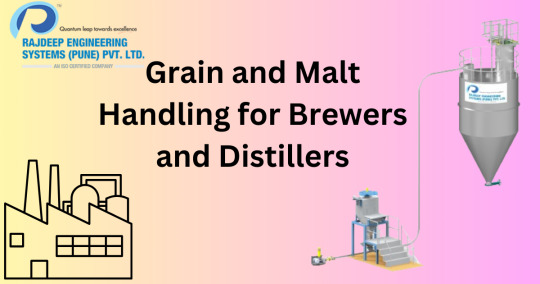
#pneumatic conveyor process#pneumatic conveying#pneumatic conveying system#pneumatic conveying systems
0 notes
Text
Everything You Need To Know About Malted Milk Food in India
Malt is a grain product that provides nutrition, taste, and a foundation for fermentation in food and drink. Partially germinating cereal grains change their natural food components, which is how Malt Based Food is made. Barley is the most common cereal grain used to make malt, but rye, wheat, rice, and maize are all viable options.

Malt Syrup, What Is It?
As its name suggests, malt is the primary ingredient of malt syrup, a complex sweetener. By boiling and condensing the wort, its sweetness is enhanced, and it thickens into sticky syrup. For all its versatility, malt syrup is most often thought of as a sweetener in connection with bagels and dark, spicy baked goods such as gingerbread and pumpernickel.
Malt Powder, What Is It?
Malt powder, like malt syrup, is made from wort. However, the wort is dried to a crisp instead of reduced by heating. Malt powder comes in two varieties, diastatic and non-diastatic, and it serves various purposes.
Malted Milk Production
One way to make malted milk is to mix milk with the mash liquor that is made by mashing barley malt and wheat flour. In addition to imparting a distinct taste of malted milk food in India, the enzyme found in barley malt facilitates the conversion of starch to sugar. In a nutshell, the steps involved are as follows:
Mash production - After being malted, the barely is sieved to eliminate any dust or other impurities. After that, it's combined with premium wheat flour and crushed in an in-line roller mill. The ratio of dried Barley Malt Extract to wheat flour is typically about 2.5:1
Prepare the mixture - A mix preparation tank is used to combine the wort that is collected from the mashing area with standardized milk, sugar, salts, minerals, vitamins, malt extract that has been diluted and pasteurized, and other ingredients. The addition of milk solids boosts the product's nutritional content by supplying high-quality fat, protein, minerals, and vitamins
Drying and evaporation - The mixture, which contains around 26% solids, is concentrated in a vacuum evaporator until half to two-thirds of the water is evaporated. A high vacuum is maintained, and continual agitation is used to aid the removal of water and avoid excessive caramelization.
Conclusion
In short, the procedure entails soaking the grain in water to facilitate sprouting and then drying it with hot air to prevent germination. Not only does Barley Malt Powder provide a number of essential nutrients, but it may also help with digestion, lower cholesterol, boost mood, and make you feel better overall.
For more information about: Malt Based Food Please visit at https://www.mahalaxmimaltextract.com/
#liquid malt extract#barley malt powder#malt extract powder#barley malt extract#malt extract powder manufacturer#malted barley powder manufacturers#barley malt extract manufacturers#malt extract liquid#malt extract#barley malt flour
0 notes
Text
The Evolution of Blenders in Modern Kitchens
In the modern kitchen, a blender is not just an appliance; it's a gateway to culinary creativity and healthy living. Over the years, blenders have evolved from simple gadgets for mixing drinks to versatile tools capable of handling everything from smoothies and soups to nut butter and dough. This transformation has made them indispensable in households around the world, catering to the fast-paced lifestyle of the 21st century while encouraging nutritional wellness.
A Brief History of Blenders
The journey of blenders began in the early 20th century, but it wasn't until the 1930s that the first blender specifically designed for making malts and milkshakes was introduced by Stephen Poplawski. This invention revolutionized kitchen appliances by providing a way to blend ingredients thoroughly and quickly. Over the decades, blenders have undergone significant improvements in power, design, and functionality, evolving into the multifunctional tools we rely on today.
Types of Blenders
Countertop Blenders: These are the most common type found in kitchens. With a jug mounted on a base that houses the motor, countertop blenders are designed for a variety of tasks from pureeing soups to crushing ice.
Immersion Blenders: Also known as stick or hand blenders, these are handheld devices that can be immersed directly into a pot or bowl. They're ideal for blending soups and sauces and offer easy cleanup.
Personal Blenders: Designed for single servings, personal blenders are compact and often come with travel lids. They're perfect for smoothies and shakes on the go.
High-Performance Blenders: These are designed for more intensive tasks that regular blenders might struggle with, such as making nut flours, blending frozen fruits, and even grinding grains.
0 notes
Text
Latin America Barley Market: Examining Regional Trends and Market Potential
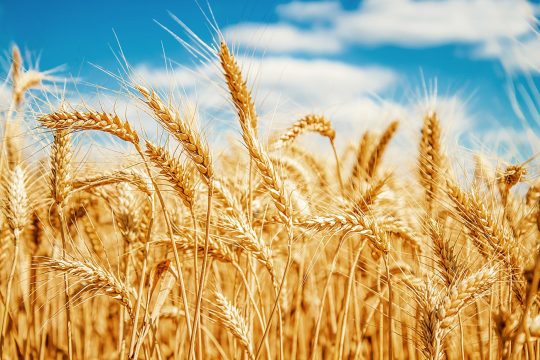
The Latin America barley market represents an essential raw material for industries such as food and animal feed. Barley is primarily used as an ingredient in beer production, accounting for over 70% of global barley consumption. The grain offers desirable qualities like enzymes that degrade starch into fermentable sugars during the mashing process. Some key advantages of barley include high mineral content, soluble and insoluble fiber helping support digestive health. The increasing consumer preference for craft beer made from natural ingredients is driving barley demand considerably.
The Global Latin America Barley Market is estimated to be valued at US$ 3.44 Bn in 2024 and is expected to exhibit a CAGR of 3.5% over the forecast period 2023 to 2030.
Key Takeaways
Key players operating in the Latin America barley are Grain crop Limited, Malteurop Group, Soufflet Group, Crisp Malting Group, Global Malt Gmbh & Co. Kg, Ireks Gmbh, Muntons Plc, Maltexco S.A., Grain Millers, Inc, EverGrain, Malt Products Corporation, and Briess Malt & Ingredients Co. These major players are focusing on capacity expansion plans and new product launches to leverage growth opportunities.
The growing consumption of craft beer in the region has boosted barley demand significantly. Countries like Brazil, Argentina, and Chile have witnessed double digit growth in craft beer sales in recent years. Additionally, changing consumer preferences towards healthy food products has augmented the demand for barley flour and barley tea extracts.
Leading players are investing in advanced malting technologies to produce specialized barley varieties with enhanced enzyme activity. New techniques help craft unique beer flavors through precise control over germination and kilning processes. This has allowed development of novel product categories.
Market Trends
Two wheel usage is on rise in Latin America cities driven by concerns over congestion and pollution. E-bikes and e-scooters provide a convenient alternative to private vehicles and public transit. This has incentivized local administrations to invest in cycling infrastructure expansion.
Growing health awareness among consumers has boosted demand for low glycemic, gluten-free alternatives. Companies are leveraging this opportunity by introducing protein-rich barley variants for food and beverage applications.
Market Opportunities
Rising adoption of plant-based diets and veganism across Latin America creates scope for barley-based meat substitutes. Protein-rich barley possess nutritional credentials for developing meat analogs through precision fermentation.
The untapped emerging craft brewery markets in Central and South America offer significant growth potential. Local producers arewell positioned to cater niche specialty beers utilizing diverse barley strains suitable for the regions variedclimatic conditions.
In summary, the Latin America barley market is driven by thriving beverage and food industries along with growing consumer preference for sustainable products. Ongoing technological advancements will allow barley to penetrate new applications over the coming years.
Impact of COVID-19 on Latin America Barley Market Growth
The COVID-19 pandemic has significantly impacted the growth of the Latin America barley market. During the initial lockdown phases in 2020, both production and supply chains were severely disrupted. Farmers faced difficulties in sourcing inputs and harvesting products on time due to restrictions on movement. This led to a decline in barley cultivation across countries like Brazil, Argentina and Chile which are major producers in the region.
On the demand side, closure of hotels, restaurants and bars due to lockdowns reduced beer consumption substantially. Since barley is a key raw material in brewing, its demand from the beverage sector dropped sharply. The processing and malting industry also came to a standstill as plants were either closed or operated at low capacities to maintain social distancing norms. Exports of malt and barley fell steeply during this period.
However, with gradual lifting of lockdowns and resumption of economic activities from late 2020, the market is recovering. Farmers are regaining momentum and increasing area under barley cultivation. Though demand from the on-trade channel remains low, offtake from retail outlets is picking up to make up for lost volumes. Malting companies are operating at higher utilization levels now. The market is forecast to grow at a steady pace in the coming years, supported by growing beer consumption in the region along with initiatives to boost barley production. However, the threat of subsequent COVID waves remains a key challenge.
In terms of geographical concentration, the barley market in Brazil accounts for around 45% of the total Latin American market value currently estimated at US$ 3.44 billion for 2024. As the largest producer and consumer, Brazil dominates barley cultivation as well as processing for malt and beer manufacture across the region.
The fastest growing market for barley in Latin America is expected to be Chile over the forecast period of 2023-2030. Beer consumption in Chile has been increasing at a healthy CAGR of over 4% during the past 5 years. Furthermore, Chilean farmers are diversifying into barley owing to attractive government incentives and higher yielding varieties. This has pushed up barley output in the country significantly higher than Latin American average growth in recent years. Going forward, conducive government policies promoting barley and steady expansion of the brewing industry will drive Chile's barley sector at a faster rate than other regional markets.
0 notes
Text
Exploring Different Types of Millets and Their Uses.
Millets, regarded as ancient grains, have garnered substantial acclaim owing to their exceptional nutritional composition and adaptability in the culinary realm. These diminutive seeds, cultivated across centuries, boast a remarkable array of health advantages and versatile applications. They've seamlessly woven themselves into the fabric of diverse glo bal cuisines, presenting an indispensable ingredient appreciated for its multifaceted contributions.
These small-seeded grains stand as a testament to their enduring value, offering an abundance of health benefits and a broad spectrum of culinary uses. Their extensive cultivation over time has solidified their role as a pivotal ingredient in various cuisines worldwide, earning them a revered status due to their remarkable versatility and significant nutritional content.
Types of Millets
Pearl Millet (Bajra): Primarily grown in India and Africa, pearl millet is rich in protein, fiber, and essential minerals. It's commonly used to make flatbreads, porridge, and fermented beverages.
Finger Millet (Ragi): Popular in South India, finger millet is abundant in calcium, iron, and amino acids. It's utilized in dishes like idlis, dosas, and malted beverages.
Foxtail Millet (Kangni): With a nutty flavor, foxtail millet is a good source of carbohydrates and dietary fiber. It's used in making rice substitutes, porridge, and baked goods.
Proso Millet (Chena): This millet variety is versatile and used in diverse dishes globally, from bread to couscous due to its neutral taste and quick cooking time.
Little Millet (Kutki): Known for its digestible fiber content, little millet is utilized in making upma, porridge, and traditional Indian dishes.
Millets Uses
Culinary Versatility: Millets serve as a versatile ingredient, lending themselves to an array of culinary creations. They can be ground into flour for baking bread, used as a rice substitute, or incorporated into porridges, pancakes, and savory dishes.
Gluten-Free Alternative: Their gluten-free nature makes millets an ideal substitute for individuals with gluten intolerance or celiac disease. They offer a wholesome option for those seeking gluten-free diets without compromising taste or nutritional value.
Nutritional Powerhouse: Millets are rich in nutrients such as fiber, protein, vitamins, and minerals like magnesium, iron, and calcium. They contribute to improved digestion, enhanced energy levels, and overall well-being.
Environmental Sustainability: Millets are resilient crops that require fewer resources like water and fertilizers compared to other grains. Their cultivation contributes to sustainable agricultural practices and biodiversity preservation.
Diverse Culinary Applications: From breakfast cereals to traditional dishes and innovative recipes, millets bring a unique texture, flavor, and nutritional profile to various cuisines globally.
Animal Feed: Beyond human consumption, millets are also used as fodder for livestock due to their high nutritional value, promoting healthier livestock and sustainable animal husbandry.
Soil Health: These grains are known for their ability to grow in diverse soil conditions, contributing to soil fertility and preventing erosion, thereby supporting sustainable farming practices.
Health Benefits: Regular consumption of millets is associated with lower risks of heart diseases, diabetes, and obesity. Their low glycemic index aids in better blood sugar management.
Food Security: Millets are essential in regions prone to harsh climates or low agricultural productivity, providing a reliable source of nutrition and income for farmers.
Culinary Innovation: Chefs and food enthusiasts worldwide are exploring innovative ways to incorporate millets into modern cuisine, promoting their use in fine dining and culinary trends.
Criteria for Selecting Millet Exporters
Quality Assurance: Look for exporters who adhere to international quality standards, ensuring the highest quality millets.
Certifications: Check for certifications like ISO, FSSAI, or organic certifications that validate the exporter's commitment to quality and safety standards.
Product Range: A reliable exporter should offer a diverse range of millet varieties to cater to different consumer needs.
Sourcing and Sustainability: Opt for exporters who emphasize sustainable farming practices and ethical sourcing, ensuring environmentally conscious production.
Milleton Agro Pvt. Ltd - Your Reliable Millet Exporter
Milleton Agro Pvt. Ltd, a trusted name in the agro-product export industry for over 25 years, stands out as a reliable and quality-driven exporter of various agricultural products, including millets. With a commitment to delivering the finest quality, they offer an extensive range of millets, ensuring nutritional superiority and taste authenticity.
Conclusion
In conclusion, millets, with their diverse nutritional profiles and culinary versatility, stand as nutritional powerhouses in the world of grains. Understanding the varieties and their uses aids in appreciating their significance in promoting healthier diets globally. For sourcing high-quality millets, Milleton Agro Pvt. Ltd stands as a reliable and trusted exporter, ensuring top-notch products for consumers worldwide.
For your millet export requirements and further details, contact Milleton Agro Pvt. Ltd. Their dedication to quality, diverse product range, and adherence to international standards make them the go-to choice for premium agro-products.
1 note
·
View note